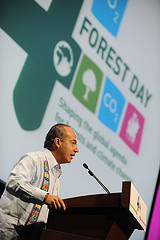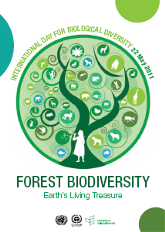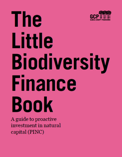| Volume 13 -
January 2011 |
The aim of this e-Newsletter is to inform CBD National Focal Points and CBD partners about biodiversity aspects in relation to reducing emissions from deforestation and forest degradation, and the role of conservation, sustainable management of forests and enhancement of forest carbon stocks in developing countries (REDD-plus). To subscribe, please visit http://www.cbd.int/forest/redd/newsletters/.
To unsubscribe, please click
here.
|
|
NEWS
Regional Workshops on Biodiversity Safeguards
Based on
Decision X/33, the CBD Secretariat is organizing a series of regional consultation and capacity building workshops on biodiversity
aspects of REDD-plus, including on relevant safeguards. The first workshop, for the Asia-Pacific region, will take place from 15-18 March
2011 in Singapore. More:
http://www.cbd.int/doc/notifications/2010/ntf-2010-218-redd-en.pdf .
CBD at UNFCCC COP 16 / CMP 6 – Cancun, Mexico
 |
Rio Conventions' Ecosystems and Climate Change Pavilion:
 In Cancun, the
Ecosystems Pavilion had an exhibit, a meeting space, and a
series of associated events on topics highlighting the linkages
between biodiversity, climate change and sustainable land
management. Presentations and recordings from the events can be
accessed at:
http://www.ecosystemspavilion.org/en/cancun, and videos, photos
and interviews are available at:
http://www.ecosystemspavilion.org/en/nagoya-videos.
In Cancun, the
Ecosystems Pavilion had an exhibit, a meeting space, and a
series of associated events on topics highlighting the linkages
between biodiversity, climate change and sustainable land
management. Presentations and recordings from the events can be
accessed at:
http://www.ecosystemspavilion.org/en/cancun, and videos, photos
and interviews are available at:
http://www.ecosystemspavilion.org/en/nagoya-videos.
|
 |
 Forest Day 4:
Forest Day 4
was co-hosted by the Center for International Forestry Research (CIFOR),
the Mexican National Forestry Commission (CONAFOR), and members of the Collaborative Partnership on Forests (CPF), including
the Convention on Biological Diversity. It brought together more than 1,500 of the world's leaders and experts, practitioners
and policy makers, advocates and investors, indigenous people, community representatives, and the media to discuss the integration
of forests into climate mitigation and adaptation from local to global levels. A summary of Forest Day 4 is available at:
http://www.forestsclimatechange.org/?id=412. Forest Day 4:
Forest Day 4
was co-hosted by the Center for International Forestry Research (CIFOR),
the Mexican National Forestry Commission (CONAFOR), and members of the Collaborative Partnership on Forests (CPF), including
the Convention on Biological Diversity. It brought together more than 1,500 of the world's leaders and experts, practitioners
and policy makers, advocates and investors, indigenous people, community representatives, and the media to discuss the integration
of forests into climate mitigation and adaptation from local to global levels. A summary of Forest Day 4 is available at:
http://www.forestsclimatechange.org/?id=412.
|
 Forest Biodiversity as the Theme of the International Day for Biological Diversity and International Year of Forests
Forest Biodiversity as the Theme of the International Day for Biological Diversity and International Year of Forests
The theme for the International Day for Biological Diversity (IDB)
in 2011 is Forest Biodiversity. IDB is being celebrated on 22 May as part of the
International
Year of Forests. More: http://www.cbd.int/idb/doc/2011/idb-2011-booklet-en.pdf .
Online resources on carbon, biodiversity and ecosystem services
The UN-REDD Programme pages on the multiple benefits of REDD+ provide access to a wide range of resources on ecosystem-based benefits, including an introductory brochure
'Beyond Carbon'. Amongst other materials, the website houses the Multiple Benefits Series of technical and issue papers. Your comments on these web pages are welcome. Visit:
http://www.un-redd.org/AboutUNREDDProgramme/GlobalActivities/New_Multiple_Benefits/tabid/1016/Default.aspx .
 Old technology is new again for people and trees in Borneo
Use of a motorized winch – instead of a bulldozer – to remove harvested timber is being tested at Indonesian Borneo logging concessions. Supported by USAID, Indonesia Ministry of Forestry and The Nature Conservancy's Responsible Asian Forestry & Trade (RAFT) program, this sustainable forestry approach has created local jobs, caused less soil disruption and released less carbon from damage to surrounding forest.
More: http://www.nature.org/initiatives/climatechange/features/art32870.html and http://change.nature.org/2011/01/12/the-power-of-22-horses-and-cable-winch/.
Old technology is new again for people and trees in Borneo
Use of a motorized winch – instead of a bulldozer – to remove harvested timber is being tested at Indonesian Borneo logging concessions. Supported by USAID, Indonesia Ministry of Forestry and The Nature Conservancy's Responsible Asian Forestry & Trade (RAFT) program, this sustainable forestry approach has created local jobs, caused less soil disruption and released less carbon from damage to surrounding forest.
More: http://www.nature.org/initiatives/climatechange/features/art32870.html and http://change.nature.org/2011/01/12/the-power-of-22-horses-and-cable-winch/.
|
|
PUBLICATIONS
 "The Little Biodiversity Finance Book"
"The Little Biodiversity Finance Book"
The Global Canopy Programme is pleased to announce its latest publication on innovative finance for biodiversity and ecosystem services. The Little Biodiversity Finance Book estimates that between USD 36 - 38 billion per annum is currently being spent on natural capital and explores ways to raise up to USD 141 billion per annum by 2020.
To find out more go to:
www.globalcanopy.org/go/biodiversityfinance.
"Biodiversity Conservation in the REDD"
REDD+ has potential to combat global climate change and save threatened biodiversity as a co-benefit of protecting forests. This paper shows, however, that in Indonesia, protecting forests providing the largest carbon savings benefits a small portion
of Indonesia's most threatened biodiversity. The authors warn that implementing REDD+ without a regulatory framework to guide biodiversity co-benefits could undermine, not enhance, long-term prospects for biodiversity conservation. Visit:
http://www.cbmjournal.com/content/5/1/7.
|
| Click here for more information on REDD-plus |

How can you publish in this Newsletter?
Your contributions to this Newsletter on issues related to biodiversity
aspects of REDD-plus are welcome. Please send your submission to redd@cbd.int. Articles should contain no more
than 60 words, and must contain a hyperlink for more information. For more information please see:
http://www.cbd.int/forest/redd/newsletters/
Deadline to submit articles for the next issue: 11 March 2011.
This Newsletter is published pursuant to CBD decision IX/5. The views expressed in this publication do not necessarily reflect the views of the Secretariat of the CBD.
|
|
Photo credits (from top to bottom): Ecosystems Pavilion, CIFOR, CBD, Ecosystems Pavilion, Global Canopy Programme |


 Old technology is new again for people and trees in Borneo
Use of a motorized winch – instead of a bulldozer – to remove harvested timber is being tested at Indonesian Borneo logging concessions. Supported by USAID, Indonesia Ministry of Forestry and The Nature Conservancy's Responsible Asian Forestry & Trade (RAFT) program, this sustainable forestry approach has created local jobs, caused less soil disruption and released less carbon from damage to surrounding forest.
More: http://www.nature.org/initiatives/climatechange/features/art32870.html and http://change.nature.org/2011/01/12/the-power-of-22-horses-and-cable-winch/.
Old technology is new again for people and trees in Borneo
Use of a motorized winch – instead of a bulldozer – to remove harvested timber is being tested at Indonesian Borneo logging concessions. Supported by USAID, Indonesia Ministry of Forestry and The Nature Conservancy's Responsible Asian Forestry & Trade (RAFT) program, this sustainable forestry approach has created local jobs, caused less soil disruption and released less carbon from damage to surrounding forest.
More: http://www.nature.org/initiatives/climatechange/features/art32870.html and http://change.nature.org/2011/01/12/the-power-of-22-horses-and-cable-winch/.
